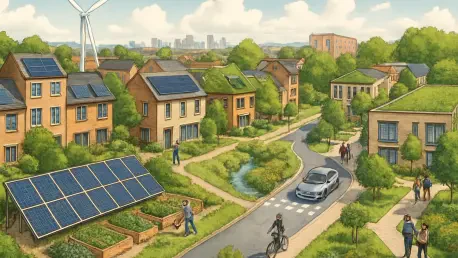Imagine a landscape where a former military base transforms into a thriving hub of sustainable living, addressing the UK’s dire housing shortage while pioneering energy innovation through a remarkable redevelopment project. This is the reality unfolding at Heyford Park, near Bicester in Oxfordshire, recently designated as a ‘New Town’ under a transformative government initiative. As urban growth pressures mount, with demand for affordable homes and green infrastructure intensifying, Heyford Park emerges as a critical case study. This market analysis explores the trends, data, and projections surrounding this ambitious redevelopment, assessing its potential to reshape the urban planning sector. The focus is on understanding whether this project can serve as a viable blueprint for balancing housing needs, economic vitality, and environmental goals in a competitive real estate and sustainability market.
Diving into Market Dynamics and Key Trends
Historical Context and Market Positioning
Heyford Park’s journey from a Cold War-era RAF airbase to a designated ‘New Town’ underscores a significant shift in the UK property and urban development markets. Once decommissioned in the 1990s, the site lingered as a brownfield asset, underutilized until early redevelopment efforts introduced over 1,500 homes and basic amenities. This repositioning reflects a broader trend of repurposing dormant land to meet housing demands, a strategy gaining traction as greenfield sites face stricter environmental scrutiny. The site’s strategic location near the Oxford-Cambridge growth corridor further enhances its market appeal, positioning it as a high-potential zone for investors and developers eyeing long-term returns in mixed-use projects.
Housing Sector Insights and Growth Projections
The housing market at Heyford Park is poised for substantial expansion, with plans to construct up to 13,000 new homes over the coming decades. This ambitious target directly addresses the UK’s chronic housing shortage, where demand consistently outstrips supply, especially in high-growth regions like Oxfordshire. Beyond sheer numbers, the development prioritizes community cohesion through integrated infrastructure—schools, green spaces, and transport links are embedded in the masterplan led by Dorchester Living. Market data suggests that such holistic approaches can boost property values by fostering buyer confidence in long-term livability, though challenges like maintaining affordability amid rapid scaling remain a concern for stakeholders.
Economic Opportunities and Job Market Expansion
Economically, Heyford Park is set to become a powerhouse, with projections estimating the creation of up to 7,000 jobs, particularly in CleanTech, low-carbon industries, and creative sectors. This focus aligns with market trends favoring sustainable economic hubs over traditional dormitory towns, as businesses increasingly seek locations with green credentials to attract talent and investment. Positioned along a key growth corridor, the area could capture significant corporate interest, though risks such as economic downturns or sector-specific slowdowns could impact job creation timelines. If successful, this model might shift market preferences toward developments that integrate residential and employment opportunities seamlessly.
Sustainability as a Market Differentiator
Sustainability stands out as a defining feature of Heyford Park’s market strategy, with aspirations to become the UK’s first energy-surplus town through renewable energy systems, efficient building designs, and low-carbon transport solutions. This aligns with growing investor and consumer demand for eco-friendly developments, a segment projected to expand as national climate targets tighten. Market analysis indicates that sustainable projects often command premium valuations due to lower operational costs and heightened appeal to environmentally conscious buyers. However, scaling such innovations across diverse UK regions could face logistical and cost barriers, potentially limiting broader market adoption in the short term.
Future Outlook: Projections and Market Implications
Looking ahead, Heyford Park sits at the intersection of several emerging market trends in urban development. The push toward brownfield redevelopment is expected to intensify, driven by policy incentives and land scarcity, with this project potentially setting a benchmark for future initiatives. Technological advancements in renewable energy and smart infrastructure could further enhance its competitive edge, though regulatory complexities and funding constraints may temper growth rates. Analysts project that achieving energy-surplus status could position Heyford Park as a leader in the sustainable real estate market, influencing investor priorities and policy frameworks over the next decade from 2025 onward. The challenge lies in maintaining momentum amid economic uncertainties and ensuring that sustainability does not come at the expense of affordability.
Another critical aspect shaping the market outlook is the integration of economic and residential growth. As more developers recognize the value of self-sustaining communities, projects like this one could redefine investment criteria, prioritizing long-term viability over short-term gains. Market forecasts suggest that regions adopting similar models might see increased private-sector interest, especially in CleanTech and low-carbon industries. Yet, the success of such projections hinges on effective collaboration between government bodies, developers, and local communities to align on shared goals and mitigate potential conflicts over resource allocation.
Reflecting on Insights and Strategic Pathways
Looking back, the market analysis of Heyford Park reveals a multifaceted approach to urban growth that tackles housing shortages, economic development, and environmental challenges with equal rigor. The project’s scale and vision stand out as a response to pressing market needs, setting a precedent for how brownfield sites can be leveraged for maximum impact. Key implications include the growing investor appetite for sustainable developments and the potential for economic hubs to redefine regional markets.
Moving forward, stakeholders should prioritize strategic partnerships to ensure that infrastructure keeps pace with housing expansion, safeguarding market confidence. Developers and policymakers might consider incentivizing CleanTech investments through tax breaks or grants to accelerate job creation. Additionally, continuous engagement with residents could help tailor growth to local needs, enhancing market stability. As the UK real estate sector evolves, Heyford Park’s journey offers a compelling roadmap for balancing profit with purpose, urging industry players to rethink traditional models of urban expansion.









